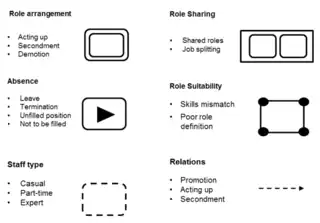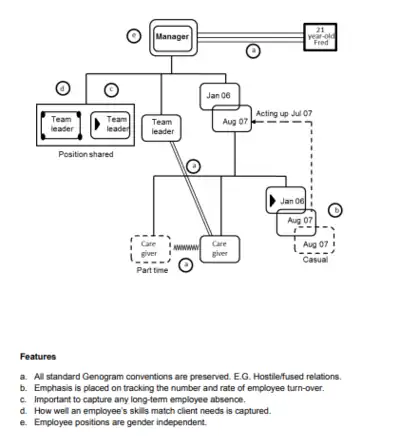Systogram
A systogram in its simplest form is an extended genogram,.[1] But unlike a genogram a systogram comprises a simplified organizational chart, symbols and various relational markers. These together depict the relevant structures and people setup to provide services to any one or more groups of people requiring therapy or therapeutic care and support. Services may include for example, allied health, accommodation and respite for people with intellectual disability and or other disabilities, schools for children with specific needs, specialist aged care, and other assistive supports such as outreach and community-based programs.
Systograms allow clinical practitioners to visualize systemic patterns and psychological factors that punctuate relationships [1] between care givers and between care givers and clients. It can be used to identify repetitive patterns of behavior and to recognize parallel constructs otherwise found in traditional family therapies.[2][3] Jack Dikian invented the concept of the systogram during the development and application of Systemic hypothesising and systemic consultation [4] in early 2013 to augment more traditional behaviour assessment analysis,[5] clinical case formulation and case consultation. Genograms, sociograms and systograms have been used effectively to support and facilitate such approaches as in the case of systemic hypothesising and clinical case formulation[6] Systograms are now used by various groups of people in a variety of fields such as behaviour management, psychology[7] and case management.
Symbols
A systogram is created using the most relevant part of an organizational chart as its basis. This chart is then overlayed with systogram symbols representing role characteristics including, for example, role titles, role types, how roles are filled, whether they are experiencing significant absenteeism, and whether there are mismatches between key roles and people holding those position. Other notations can be made to signal relevant experience levels, skills, job fit, and other important job-related properties as they apply to the needs of the client and their family. In addition, many of the familial and emotional markers[8] found in genograms can applied in the creation of a systogram. Systogram symbols will usually have the names of the professional, the number of years they have held a particular position and any other facts that might impact or affect the appropriateness and efficacy of the service provided.

Content
A systogram can contain a wealth of information about an organization and its people. It will show the names of the people and that part of the organization structure most relevant in the provision of support and any other service. A number of organizational charts can be used or combined in order to depict, for example, the multi-organizational nature of managing complex clinical cases. A systogram can reveal, for example, how a care worker from one organization is working with a psychologist from another organization. In the same way a genogram can be used to illustrate, say a separation or a divorce, the same relational markers are used to indicate a person changing roles, or leaving the organization entirely. Work in systemic hypothesising and learnings from family systems has shown that the separation, say, of a vulnerable child from his or her favorite school teacher can sometimes prompt a similar emotional response as if that child was separated from another family member.[9] Relational markers such as distrust, psychological abuse, hostility, can be shown to exist between care providers and between care providers and clients in a systogram.

Psychology
Since the mid-1990's, there has been an increase in the recognition of the critical role of relationships,[10] including family relationships as well as those between clients and carers in the maintenance and amelioration of challenging behaviour, as well as in attempts to integrate the fields of family therapy and applied behaviour analysis [5] using such methods as systemic hypothesising or systemic consultation. These approaches use system models such as genogram, sociogram and to a lesser extent systograms,[11] to help study and record relationship patterns (within the family and external systems such as schools and other care providers) and the individual characteristics that may be contributing to repetitive and challenging patterns of behavior.[12]
Social work
In social work, genograms, sociograms and systograms[13] are used to display emotional bonds between individuals composing a family or social unit. A systogram will help social workers to make an assessment of the level of cohesiveness and relational appropriateness within a family, the support system (including for example, schools, churches, youth facilities, associations or retirement homes) and the social environment.
References
- Jolly, W.; Froom, J.; Rosen, M. G. (1980). "The genogram". The Journal of Family Practice. 10 (2): 251–255. PMID 7354276.
- Friedman, H.; Rohrbaugh, M.; Krakauer, S. (1988), "The time‐line genogram: Highlighting temporal aspects of family relationships", Family Process, 27, 27 (3): 293–303, doi:10.1111/j.1545-5300.1988.00293.x, PMID 3224700
- Hoffman, Lynn (March 1990). "Constructing Realities: An Art of Lenses". Family Process. 29 (1): 1–12. doi:10.1111/j.1545-5300.1990.00001.x. PMID 2178969.
- Rhodes, Paul; Donelly, Michelle; Whatson, Lesely; Dikian, Jack; Hansson, Andres; Mora, Lucinda (June 2012). "Systemic hypothesising for challenging behaviour in intellectual disabilities: a reflecting team approach". Australian and New Zealand Journal of Family Therapy.
- Carr, E; Durrand, V. (June 1985). "Reducing behaviour problems through functional communication training". Journal of Applied Behavior Analysis. 18 (2): 111–126. doi:10.1901/jaba.1985.18-111. PMC 1307999. PMID 2410400.
- Perry, Samuel; Cooper, Arnold (April 2018). "The Psychodynamic Formulation: Its Purpose, Structure, and Clinical Application". Psychiatry Online.
- Bauer, Malcolm; Johnson-Laird, P. (April 1993). "How Diagrams Can Improve Reasoning". Psychological Science. 4 (6): 372–378. doi:10.1111/j.1467-9280.1993.tb00584.x. S2CID 18346305.
- Cornelia, Rada; Turcu, Suzana (2012). "Family psychological markers in a systemic and anthropological approach". International Journal of Collaborative Research on Internal Medicine. 4 (6).
- Rhodes, Paul; Donelly, Michelle; Whatson, Lesely A.; Dikian, Jack; Hansson, Andres; Mora, Lucinda (June 2013). "Beyond the Impasse? Systemic Consultation and Understanding Complex Cases". Journal of Applied Research in Intellectual Disabilities. 1.
- Boscolo, L; Bertrando, P (2019). "The Times of Time: A Perspective on Time in Systemic Therapy and Consultation". United Kingdom: Taylor & Francis.
- "Systogram beyond genograms and sociograms". Academia. 25 February 2015. Retrieved 26 June 2015.
- Rhodes, Paul; Donelly, Michelle; Whatson, Lesely; Dikian, Jack; Hansson, Andres; Mora, Lucinda (June 2012). "Systemic hypothesising for challenging behaviour in intellectual disabilities: a reflecting team approach". Australian and New Zealand Journal of Family Therapy.
- Appleton, Jane; Terlektsi, Emmanouela; Coombes, Lindsay (April 1993). "The use of sociograms to explore collaboration in child protection conferences". Children and Youth Services Review. 35 (12).
Bibliography
Jack Dikian: Systogram, beyond Genograms: Symbols and conventions for use in service-based systemic therapies, ASIN 00PKYI2TM (2014)